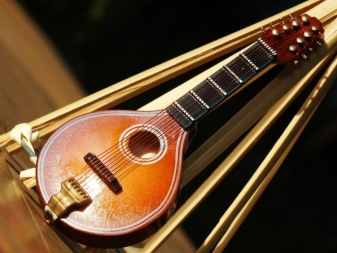What is mandolin and what is the instrument like?
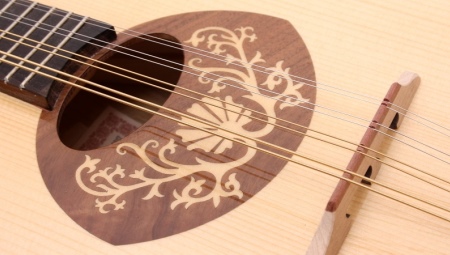
The mandolin is one of the most famous stringed instruments in Italy, Spain and other Western European countries. During the existence of this instrument, many of its varieties have appeared. The most popular and common mandolin models are Neapolitan and Lombard. On the mandolin, you can reproduce a long sound of one note using the tremolo technique and a special playing technique.
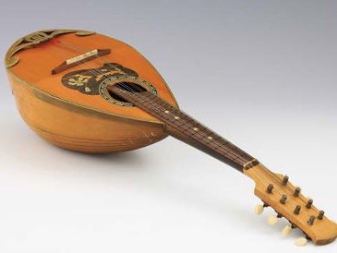
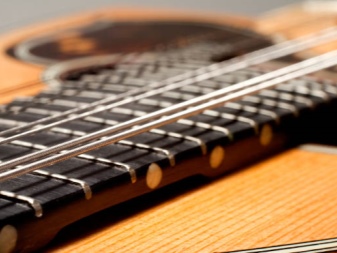
What it is?
Mandolin treat to stringed plucked instruments, it is a lute subspecies from the class of chordophones. It can be considered an Italian national musical instrument. The oval body of the instrument acts as a resonator. The classic shape of the body is pear-shaped. A neck with 18 frets is attached to it (the number may vary depending on the type). The number of strings varies from 8 to 12 and depends on the instrument model. It uses metal strings that stretch along the entire length of the neck and body. The most common tuning is G3-D4-A4-E5. The special structure of the mandolin allows musicians to effectively use the tremolo technique.
The tool body is made of hardwood. The ribs are most often made from rosewood, maple or cherry. And for the soundboard they use spruce or cedar. Classic models have a teardrop-shaped top that is flat, while the bottom is usually slightly convex. This shape gives the softest and softest sound of the instrument. Other forms give a sharper sound. Case dimensions differ depending on the model. The average size of the instrument is about 60cm, most of it (33-35cm) is the body and the rest is the neck with pegs at the tip.
The neck is made of maple, cedar or larch, and the head is made of metal. In the old days, it was made of ivory or very strong wood. Fret dividers on the fretboard are also available in ivory or metal. The fretboard stand can be moved, it is not secured. By moving it, you can achieve more precise tuning of the instrument. Notes for mandolin are written in the treble clef. They are similar to real sound. You can play chords on the instrument.
Tabs (tablatures) for this are written in the same way as guitar ones. Almost all tablatures written for other strings can be used for mandolin playing.
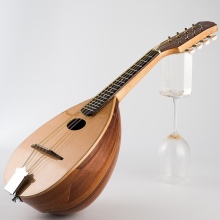
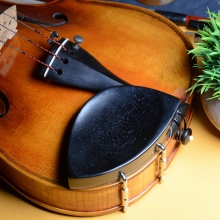
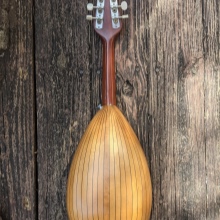
Origin story
Italy can be considered the birthplace of the instrument. Mandolin comes from the ancient Arabic instrument oud. It first appeared around the 17th century. It was a Milanese model, it had 4-6 strings and was shaped like a classical lute. After that, its shape and technical characteristics have undergone changes. Finally, in 1835, it acquired its finished look, which it has preserved to this day. From that moment on, it became possible to install metal strings. The size of the instrument became large, the number of frets on the neck increased to 17. The modern shape of the instrument was created by the Vinachia family of musicians from Naples. They created a curved soundboard and began to tune the instrument in fifths (like a violin). The name of this model (Neapolitan mandolin) has gone from the name of the city.
It is she who is considered a classic instrument. Starting this year, Neapolitan ensembles and trios are gaining more and more popularity, performing Tuscan folk songs to the beautiful accompaniment of a mandolin. Today, there are even annual music competitions held among such ensembles and vocalists. The famous T. Kottrau took part in such a competition with the song Santa Lucia, accompanied by a mandolin. One original mandolin made by the Vinachia family is still in the British Museum and dates from 1744. The first models of the instrument can be seen in museums in the USA, Italy and Spain.
The word "mandolin" comes from the name of another similar instrument - the mandola. The mandola is larger in size, so its smaller version is popularly called the mandolin.
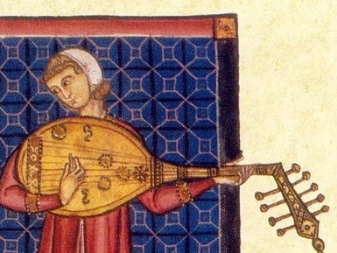
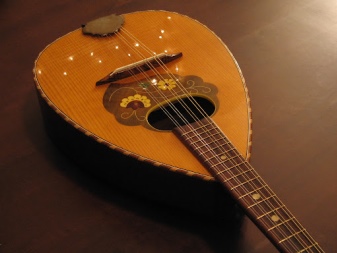
Since the 17th century, mandolins have been played in orchestras when performing operas and cantatas. The mandolin quickly gained popularity due to its unusual sound. They began to write solo parts for the instrument in concert programs. In Paris, they began to release collections of musical works especially for this wonderful instrument, and vocals were also included there.
In Russia, the mandolin appeared around 1785 (in St. Petersburg and Moscow), but it did not gain popularity. Serenades were performed on it, but in Russia at that time they were not, therefore, the mandolin was not in demand. For the first time a mandolin was brought to Russia by theatrical corpses from Italy. Closer to 1880, it spread, first in the European part, and then throughout Russia. Mandolin began to be included in the repertoires of popular musical evenings. The Mandolin Society was established. In the 1900s, the production of self-instructional books and sheet music began. They were oriented towards mandolin and domra, which are similar in pitch and range. Since 1926, their own production of tools has been established in factories throughout the country. A new model was even developed with a double top deck, which improved the sound of the instrument.

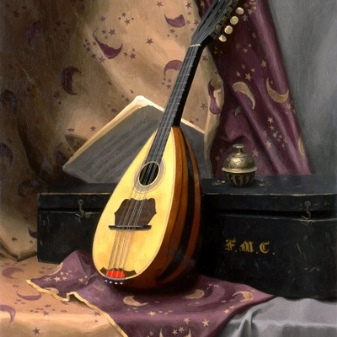
Species overview
The classic type of mandolin is the Neapolitan model with 8 strings (4 pairs of strings). She has received the widest distribution around the world. But other types are widely used by musicians of different genres. All models can be divided into 2 groups: A-style and F-style.
- A-style models are oval in shape with arched elements, which makes them look like a small guitar or violin.The top is flat, often with carvings. These mandolins are popular with folk and Celtic musicians. They are also suitable for classical music.
- F-style models (Florentine) have a ledge at the bottom of the soundboard. These tabs help musicians to position the instrument comfortably when they are seated. Such instruments are popular with country musicians. On the basis of this shape, other mandolin models have been developed: both the classic eight-stringed teardrop shape, and solutions for other shapes with a large number of strings.
All popular models differ in body shape, size, number of strings, and pitch. Each model has its own unique sound: it can be deep, soft or incredibly bright.
- Florentine... It has 5 paired strings, and the shape of the body differs from the Neapolitan model.
- Milan... Has 6 paired strings. Tune this variation an octave higher than a classical instrument. Otherwise, it is similar to the classic mandolin model.
- Sicilian... Another name is mandriola. It has 8 strings and is considered a Central European version. The eight-string model has become widespread among the peoples of Mexico, and is intended for performing folk music.
- Portuguese... The model has a flat body with resonator f-holes (like a violin). Her sound is sharper. This mandolin is often used by folk musicians in Ireland, England and Brazil.
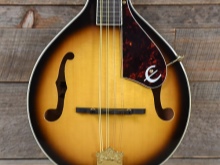
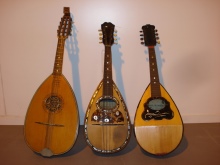
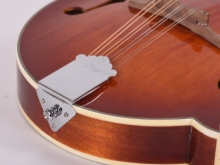
Sound
The mandolin sound is very soft and deep, but it fades quickly. The velvety sound is especially deep. The strings on the mandolin are arranged in pairs, it is customary to hit them with a pick from top to bottom and back... Many strings can be played on the mandolin: tremolo, legato, trill, vibrato, and glissando. The sound from the string on the mandolin decays quickly. Therefore, if you need to play long notes, the tremolo technique is used.
This is how the musicians manage to prolong the sound of the notes. Rapidly repetitive performance of one note merges into one long sound. The mandolin sounds peculiar, it can be used both for solo performance and in ensembles with other string instruments.
Most often it is used for performing folk songs, in the USA it is used along with banjo in bluegrass. The sound of the mandolin brings a special zest to the piece of music.

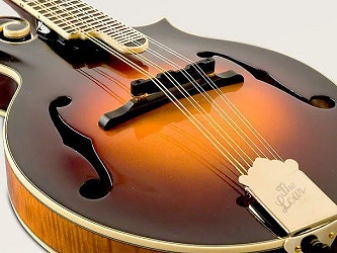
Use and repertoire
The mandolin can be used in a wide variety of ways, as it is a rather versatile instrument. You can play a solo part on it or accompany the vocalist. It is very common to see mandolin in ensembles, string trios and even large orchestras. It all depends on the music genre and the composer. Initially, the instrument was used to perform Italian folk melodies. Later they began to use it in ensembles, trios and quartets were created with various plucked instruments or only with mandolins for academic performance. Mandolin became widespread among jazz and Celtic performers in the 30s of the last century. Very often the instrument is used by performers of country and folk music.
The sound of the mandolin can be heard even among rock musicians (Led Zeppelin, R. E. M, Blackmore`s Night). The part of the instrument was performed by guitarists in groups, many iconic singles were recorded. When many rock musicians started using mandolins to perform their music, the electric variation was developed in the USA. This happened in the 30s of the XX century. There is no sound hole on the body of the electromandoline, but pickups are installed. Some models have an additional string (extended range electromandoline). The rock group "Aria" can be distinguished from the Russian performers. The mandolin can be heard on the hit Paradise Lost.
For classical music, the Neapolitan model of the mandolin is most suitable, while for other genres, you can choose any model that will be convenient to play. Mandolin is very often used in jazz, and not only by amateurs, but also by professionals. Its unusual sound enriches jazz compositions, and its body design makes it easy to improvise. Special concerts for mandolin were written by famous composers of the past: Vivaldi, Lecce, Pergolesi, Kaufmann and many others. Mozart, Verdi and Schoenberg used mandolin in their operas and other works. The beautiful gentle sound of the instrument attracts many composers and musicians today.
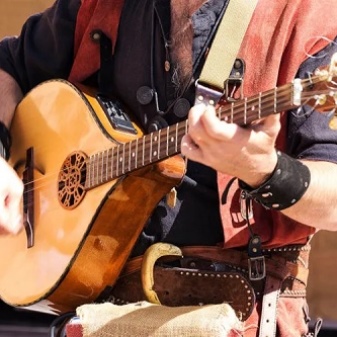

Accessories
It is customary to play the mandolin with picks of different thickness and size. The depth and brightness of the instrument sound depends on the pick. For beginners, it may be difficult at first to hold on to a thick pick, as it requires some effort and habit. Plectrum picks made from turtle shells are very popular. Today, most of these mediators are made from synthetic materials. The plectrum is an essential accessory for this instrument. It is very difficult to play with your fingers. Many people use conventional picks designed for guitar playing. But some manufacturers make plectra made specifically for mandolins.
A regular acoustic mandolin can be turned into an electric one. To do this, you need to install a pickup on the instrument. It does not require drilling holes for fasteners to install. Everything is easily installed and, if necessary, removed. In specialized stores, you can easily find sets of strings specifically for mandolins with plated (phosphoric bronze, monel metal, silver-plated metal) of various thicknesses, tuning kits, nut nuts. The strings should be changed regularly, about once every month and a half with moderate use. If you play for a few hours every day or perform at concerts, then you need to change the strings more often. Worn out rusty strings quickly become unstable and can be easily injured during active playing.
Purchase a mandolin case for easy portability. Covers are most often made from thick nylon. When choosing a case, consider the shape of your mandolin (flat or convex). Side straps are provided for carrying on the case. For home storage, you can use tool stands or wall holders.
The tuner (chromatic) is useful for tuning your instrument. With its help, you can more accurately tune each string individually, listen to their sound and check the accuracy of the tuning.

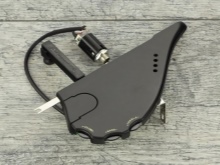
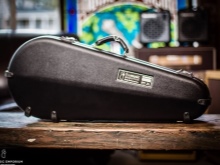
How to setup?
Setting up the mandolin correctly is not easy, especially for beginners. It is better to do this under the guidance of a master. Tuning a mandolin (Neapolitan model) is the same as tuning a violin: G, D, A, E. The paired strings of the instrument are tuned in unison. That is, a properly tuned instrument will have 2 pairs of each note. If the mandolin is held correctly, the highest E note will be on the lower string. At first, this will be difficult, it is difficult for beginners to make out which of the paired strings sounds wrong. Tune the strings separately first, then try playing them together.
First you need to tune the second string in the A range. Then it is clamped at the seventh fret and the first string is tuned in unison. The third and fourth strings should be held down at the 7th fret and tuned, the third in unison with the second, and the fourth in unison with the third. This configuration method is considered classic. Sometimes paired strings are tuned to different pitches, this is called cross-tuning. Guitarists can tune mandolin and guitar-like to get a similar fret pattern.If you think of the mandolin as part of the guitar, then it will be the bottom 4 strings, but in reverse order. Fingering patterns written for guitar are read in the same way.
When tuning correctly, you need to take into account the location of the strings on the tuning pegs. The strings for G and D are attached to the top tuners, while the A and E strings are attached to the bottom row. Start tuning from the top tuner closest to you, then move up the fretboard clockwise, that is, moving up the notes. When installing new strings on the instrument, keep in mind that they can bend the neck slightly. Therefore, first tune the notes approximately, not fully stretching all the strings. Give the fretboard and strings time to finally take shape (the strings are straightened and stretched, and the neck is slightly bent). And only after that proceed with fine tuning using the tuner. If the new strings are immediately pulled tight and tried to tune accurately, they will bounce off the tuning pegs. This can take a lot of time, effort and patience.
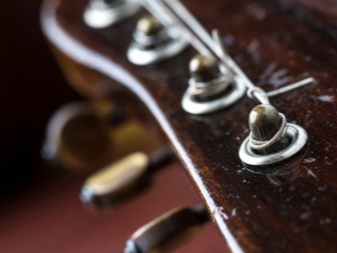

Interesting Facts
Now let's take a look at some interesting facts related to mandolin.
- The famous violin maker A. Stradivari also made mandolins. Today there are only 2 instruments left from this master. One of them is kept in the Dakota National Museum of Music.
- The classic Neapolitan mandolin is very often called the "onion" because of the shape of the body.
- In many Soviet films and cartoons, you can hear the sound of a mandolin. The most famous of them is "The Adventures of Pinocchio".
- The queen of Italy, Margarita of Savoy, was very fond of playing the mandolin. They even made a personalized instrument for her.
- Mandolin is also called a convenient grater for slicing vegetables.
